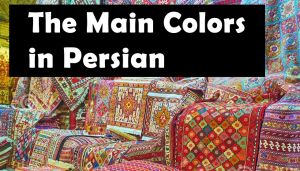Difference between revisions of "Language/Iranian-persian/Vocabulary/Colors"
| Line 1: | Line 1: | ||
<div class="pg_page_title">Persian Vocabulary ➡ The Main Colors in Farsi</div> | <div class="pg_page_title">Persian Vocabulary ➡ The Main Colors in Farsi</div> | ||
[[File:colors vocabulary in Persian PolyglotClub wiki lesson.jpg|thumb]] | [[File:colors vocabulary in Persian PolyglotClub wiki lesson.jpg|thumb]] | ||
In this lesson, we will study the main colors in Farsi, their significance in Persian culture and art, and how to use them in a dialogue. | In this lesson, we will study the main colors in Farsi, their significance in Persian culture and art, and how to use them in a dialogue. | ||
Revision as of 20:18, 1 March 2023
In this lesson, we will study the main colors in Farsi, their significance in Persian culture and art, and how to use them in a dialogue.
Additionally, there will be videos at the end of the lesson to help you practice your pronunciation.
Colors are an integral part of Persian culture and language, and understanding their meanings and usage is crucial for communication and appreciation of Persian art and traditions.
Main Colors
Here are the most important colors in Farsi :
| English | Farsi | Pronunciation |
|---|---|---|
| White | سفید | sefid |
| Black | سیاه or مشکی | siah or meshki |
| Red | قرمز or سرخ | ghermez or sorkh |
| Blue | آبی | abi |
| dark blue | آبی تیره or سرمه ای | abi tire or sormei |
| Green | سبز | sabz |
| dark green | سبز تیره or یشمی | sabze tire or yashmi |
| Yellow | زرد | zard |
| Brown | قهوه ای | ghahvei |
| Purple | بنفش | banafsh |
| Pink | صورتی | soorati |
| Orange | نارنجی | narenji |
| Gray | خاکستری | khakestari |
| Silver | نقره ای | noghrei |
| Golden | طلایی | talaei |
| Violet | ارغوانی | arghavani |
| cyan | آبی دریایی | abi daryaei |
Colors in Iranian Culture
Colors play an important role in Iranian culture and are intertwined with its rich history, traditions, and art. Iranian people have a deep appreciation for the beauty of colors and use them in many aspects of their daily lives, from clothing and home decor to art and literature. In this lesson, we will explore the vocabulary of colors in Iranian Persian, which is an essential part of the language and culture.
In Iranian culture, colors are associated with various meanings and symbolisms. For example, green is the color of nature and growth, and it represents hope and renewal. It is also the color of Islam and is often used in Iranian mosques and other religious places. Red, on the other hand, is the color of love and passion, and it is often used in weddings and other joyful occasions. It is also the color of blood and sacrifice, and it represents the struggles and sacrifices of Iranians throughout history.
White is the color of purity and cleanliness and is often used in funerals and mourning. It is also the color of winter, snow, and mountains, which are significant parts of Iranian landscape and culture. Blue is the color of the sky and the sea, and it represents calmness, serenity, and freedom. It is also the color of the ancient Persian civilization and is often used in Iranian art and architecture.
In addition to their symbolic meanings, colors also have practical uses in Iranian culture. For example, in traditional Iranian medicine, different colors are associated with different healing properties and are used to treat various illnesses. In Iranian cuisine, different spices and herbs are used to add color and flavor to dishes, and colorful fruits and vegetables are widely used in salads and other dishes.
Overall, colors are an integral part of Iranian culture and language. By learning the vocabulary of colors in Iranian Persian, you can deepen your understanding of the culture and appreciate the beauty and symbolism of colors in Iranian art and literature.
Dialogue
Here is the dialogue using colors vocabulary in Iranian Persian, including the original Persian alphabet, transliteration, and English translation:
- فاطمه: سلام مریم، حالت چطوره؟ (Fātemeh: Salām Maryam, hālet chetore?) (Fateme: Hi Maryam, how are you?)
- مریم: سلام، خوبم. تو چرا لباس سبز نپوشیدی؟ (Maryam: Salām, khobam. To chera lebās sabz naposhidi?) (Maryam: Hi, I'm fine. Why didn't you wear green clothes?)
- فاطمه: امروز قرارم با دوستان قرمز بپوشم. تو هم باید یه لباس قرمز بپوشی. (Fātemeh: Emrooz ghorāram bā dustān ghermez beposham. To ham bāyad ye lebās ghermez beposhi.) (Fateme: Today I have plans with my friends to wear red clothes. You should also wear a red dress.)
- مریم: درسته، قرمز برای من هم خوشاینده. (Maryam: Doroste, ghermez barāye man ham khoshāyande.) (Maryam: Sure, red is also pleasant for me.)
- فاطمه: یادت هست چطوری برای شادی ازدواج خواهرت صفحهی هوایی سفید پر کرده بودیم؟ (Fātemeh: Yād-et hast chetori barāye shādi-ye azdavāye khāharet safhe-ye havāyi sefid por kardim?) (Fateme: Do you remember how we filled the white sky page for your sister's wedding happiness?)
- مریم: آره، خیلی خاطرهانگیز بود. خیال میکردم چرا این همه رنگهای زیبای هوایی رو دیده بودی. (Maryam: Āre, khāli khātere-angiz bud. Khial mikardam chera in hame rang-hā-ye zibā-ye havāyi ro dide budi.) (Maryam: Yes, it was very memorable. I wondered how you thought of all these beautiful sky colors.)
